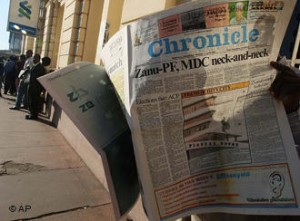Write the perfect headline!
Your choice of headline – whether for online or print media – can really make or break your story. No matter how exclusive your interview, or how fascinating your scoop – if your headline is boring or awkward you will have reduced the number of people who click on your article or turn to your story.
Not just for this reason, some reputable newspapers and news agencies around the world have their own headline specialists – experienced editors who focus on just drafting headlines. But if, like with most of us, you always have to write the headlines for your stories yourself, what are the things you should keep in mind?
Clear and concise
First and foremost, headlines need to be concise and clear to the readers. Or, as one of my colleagues likes to put it: “short and catchy”. The best way to do this is to reduce the story to it’s basic elements in the headline, but also to use active as opposed to passive sentences.
Let’s look at an example from Africa. Following the sacking of Nigeria’s main security advisor and the defense minister by Goodluck Jonathan in June 2012 after a number of terrorist bombings, it would be possible to lead with the following headline: “Security Advisor and Defense Chief jobless following further bombings in Nigeria”
This headline gets the message across – but it is long and also passive in its construction. A better solution would be to shorten the sentence and make it active. For example: “Nigerian President sacks security and defense chiefs”. When the headline contains a verb, it instantly becomes more understandable.
Have a go at a headline first
 It’s generally useful to create a working headline for your piece before you have written the text. This can be done at the same time as you are writing the “teaser”, the short text which accompanies a headline at the top of the page. Both of these elements have to work together to entice the reader in.
It’s generally useful to create a working headline for your piece before you have written the text. This can be done at the same time as you are writing the “teaser”, the short text which accompanies a headline at the top of the page. Both of these elements have to work together to entice the reader in.
Writing the headline and teaser at the start has two benefits. Firstly, it gives you an idea of where you are going with the article. Namely, what statement do you want to make with your article? Where does your focus lie? It’s also useful to help you jump into your story in the first paragraph. If you have established the right facts from the very start, then writing the piece is a lot easier.
And don’t worry: changing the headline after you have written the piece is pretty normal and nothing to be ashamed of!
Catching people’s attention
Unless you are working for a publication with very serious editorial guidelines, it’s generally fine to occasionally use jargon, abbreviations or word-plays in your headlines. But remember, you should only do this if the reader doesn’t have to think too long to understand what you are trying to say. Be creative by all means, but stick to the point.
Tabloids – especially the British publications – are renowned for using really cheeky headlines to attract readers. This is a style that they have made their own and also something that their readers now come to expect. Many of their headlines might be inappropriate for other media outlets, so it’s best to ask an editor or an experienced colleague about what the tone of your headline should be. Remember, it’s not worth defaming someone just for the sake of creating an eye-catching headline – this could cause problems for you and your publication.
Another way of catching the attention of your readership is with an interesting quote from one of the protagonists in your story. If you decide to do that, you should present the quote in quotation marks. Try to pick a quote that will spark curiosity or interest.
Finally, some technical stuff
Often the publication you are working for will have a limit of characters for its headlines – it might be 50 characters, maybe 60. That’s not much room to move, which is another reason to keep your headline concise. Obviously, it’s best to find this limitation out at the start so that you don’t waste time drafting a perfect headline that you then find out at the end you can’t use anyway.
Plenty of websites – but also newspapers who put their content online – need to put keywords in their headlines in order to maximize their success in search engines like Google. That means if you are talking about famine in Somalia, you need to mention “Somalia” and perhaps “hunger” or “drought” in your headline. Check with your webmaster as to whether this is the case.
Finally, the headline should not repeat the lead sentence of your article. Rather than being a technical problem, repetition can confuse your readers right at the very start of the process. Not something that we want to achieve!
So, time to get out there and start drafting some creative and punchy headlines. Once they’re done, don’t be afraid to try them out on your colleagues and friends to see how they react. Often they will have a good idea that can make your story even more of an “eye-catcher”.
Author: André Leslie




Feedback